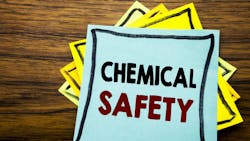The hazard communication system (HCS) regulations are covered in 29CFR1910.1200. Subsection (c) provides definitions, which, in general, people don’t like to read. But there is a reason why the definitions are listed right after the scope and applications are given. They aren’t put at the end just on the off chance you might not know a word. They precede the actual requirements so that you understand what OSHA means while you are reading those requirements.
Rather than interpret the requirements based on what a given word could mean, you must interpret the requirements based on what a given word does mean. Here’s a sampling:
Article:
- What it could mean: A piece of clothing, as in an article of clothing.
- What it does mean: A manufactured item other than a fluid or particle (and that meets three conditions listed in Subsection (c).
Distributor:
- What it could mean: A company that provides products to retailers at wholesale.
- What it does mean: A business, other than chemical manufacturer or importer, which supplies hazardous chemicals to other distributors or employees.
Hazardous chemical:
- What it could mean: A liquid that is flammable, acidic, or caustic.
- What it does mean: Any chemical which is classified as a physical hazard or health hazard, a simple asphyxiant, combustible dust, pyrophoric gas, or hazard not otherwise classified.
Immediate use:
- What it could mean: Used right away.
- What it does mean: The hazardous chemical will be used only by the person who transfers it from a labeled container and only in the workshift in which it is transferred.
Use:
- What it could mean: Open the container, and apply the chemical.
- What it does mean: To package, handle, react, emit, extract, generate as a byproduct, or transfer.
If you go back and look at each “What it could mean,” you see that’s a reasonable meaning of the term. The problem is it’s not what OSHA means. In the examples given, the difference is large.
It’s not a defense to say, “Oh, I misunderstood,” because OSHA was clear about what it meant. This issue goes beyond protecting your company against OSHA citations, too. A civil lawsuit can be ruinous. In a criminal case (one brought against the defendant by the government), the burden of proof is entirely on the government and the defendant doesn’t have to prove anything. A defendant merely has to prove reasonable doubt. But in a civil case, that is not the situation. At the very least, your company would have to prove it complied with the applicable regulations and standards.
A chemical that is dry, non-flammable, and neutral in pH can still be a health hazard. If your HCS covers only liquids that are flammable, acidic, or caustic then no matter how good the rest of your HCS is, your company may be paying out OSHA fines for HCS violations. And it may have to pay out punitive awards in civil suits.
But the very worst aspect of this issue is that by not communicating the hazards for such substances you expose fellow employees of the company to health hazards that are disfiguring, crippling, deadly, or some combination thereof. If you view the OSHA regulations on HCS as being intended to help your company protect the people who work for it, then make every effort to understand what OSHA means when it is stipulating those regulations.
About the Author

Mark Lamendola
Mark is an expert in maintenance management, having racked up an impressive track record during his time working in the field. He also has extensive knowledge of, and practical expertise with, the National Electrical Code (NEC). Through his consulting business, he provides articles and training materials on electrical topics, specializing in making difficult subjects easy to understand and focusing on the practical aspects of electrical work.
Prior to starting his own business, Mark served as the Technical Editor on EC&M for six years, worked three years in nuclear maintenance, six years as a contract project engineer/project manager, three years as a systems engineer, and three years in plant maintenance management.
Mark earned an AAS degree from Rock Valley College, a BSEET from Columbia Pacific University, and an MBA from Lake Erie College. He’s also completed several related certifications over the years and even was formerly licensed as a Master Electrician. He is a Senior Member of the IEEE and past Chairman of the Kansas City Chapters of both the IEEE and the IEEE Computer Society. Mark also served as the program director for, a board member of, and webmaster of, the Midwest Chapter of the 7x24 Exchange. He has also held memberships with the following organizations: NETA, NFPA, International Association of Webmasters, and Institute of Certified Professional Managers.
